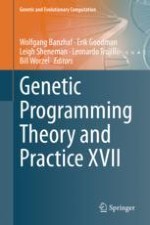2020 | OriginalPaper | Buchkapitel
14. Enhanced Optimization with Composite Objectives and Novelty Pulsation
verfasst von : Hormoz Shahrzad, Babak Hodjat, Camille Dollé, Andrei Denissov, Simon Lau, Donn Goodhew, Justin Dyer, Risto Miikkulainen
Erschienen in: Genetic Programming Theory and Practice XVII
Aktivieren Sie unsere intelligente Suche, um passende Fachinhalte oder Patente zu finden.
Wählen Sie Textabschnitte aus um mit Künstlicher Intelligenz passenden Patente zu finden. powered by
Markieren Sie Textabschnitte, um KI-gestützt weitere passende Inhalte zu finden. powered by
